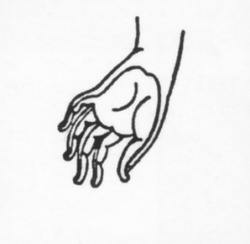Difference between revisions of "Varada (Boon-Granting) Mudra"
| Line 1: | Line 1: | ||
[[File:VaradaMudra.JPG|thumb|250px|]] | [[File:VaradaMudra.JPG|thumb|250px|]] | ||
| − | This [[mudra]] [[symbolizes]] [[charity]], [[compassion]] and boon-granting. It is the [[mudra]] of the [[accomplishment]] of the wish to devote oneself to [[human]] {{Wiki|salvation}}. It is nearly always made with the left hand, and can be made with the arm hanging naturally at the side of the [[body]], the palm of the open hand facing forward, and the fingers extended. | + | |
| + | |||
| + | |||
| + | |||
| + | This [[mudra]] [[symbolizes]] [[charity]], [[compassion]] and boon-granting. | ||
| + | |||
| + | It is the [[mudra]] of the [[accomplishment]] of the wish to devote oneself to [[human]] {{Wiki|salvation}}. | ||
| + | |||
| + | It is nearly always made with the left hand, and can be made with the arm hanging naturally at the side of the [[body]], the palm of the open hand facing forward, and the fingers extended. | ||
The five extended fingers in this [[mudra]] [[symbolize]] the following [[five perfections]]: | The five extended fingers in this [[mudra]] [[symbolize]] the following [[five perfections]]: | ||
| Line 10: | Line 18: | ||
* [[Meditative concentration]] | * [[Meditative concentration]] | ||
| − | This [[mudra]] is rarely used alone, but usually in combination with another made with the right hand, often the [[Abhaya mudra]] (described below). This combination of [[Abhaya]] and [[Varada | + | This [[mudra]] is rarely used alone, but usually in combination with another made with the right hand, often the [[Abhaya mudra]] (described below). |
| + | |||
| + | This combination of [[Abhaya]] and [[Varada mudras]] is called [[Segan Semui-in]] or [[Yogan Semui-in]] in [[Japan]]. | ||
| + | |||
| + | [[Ratnasambhava]], the third [[Dhyani Buddha]] displays this [[mudra]]. | ||
| + | |||
| + | Under his [[spiritual]] guidance, the [[delusion]] of [[pride]] becomes the [[wisdom of sameness]]. | ||
| − | + | The [[Varada Mudra]] is the key to this [[transformation]]. | |
{{R}} | {{R}} | ||
Latest revision as of 12:34, 31 January 2016
This mudra symbolizes charity, compassion and boon-granting.
It is the mudra of the accomplishment of the wish to devote oneself to human salvation.
It is nearly always made with the left hand, and can be made with the arm hanging naturally at the side of the body, the palm of the open hand facing forward, and the fingers extended.
The five extended fingers in this mudra symbolize the following five perfections:
This mudra is rarely used alone, but usually in combination with another made with the right hand, often the Abhaya mudra (described below).
This combination of Abhaya and Varada mudras is called Segan Semui-in or Yogan Semui-in in Japan.
Ratnasambhava, the third Dhyani Buddha displays this mudra.
Under his spiritual guidance, the delusion of pride becomes the wisdom of sameness.
The Varada Mudra is the key to this transformation.
